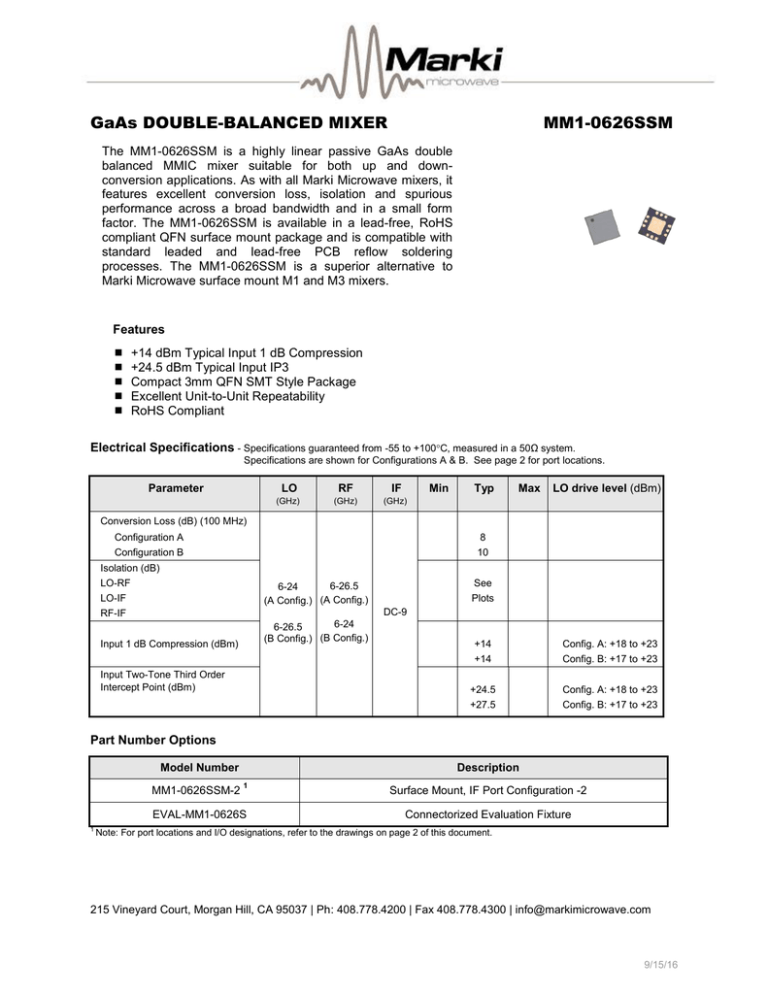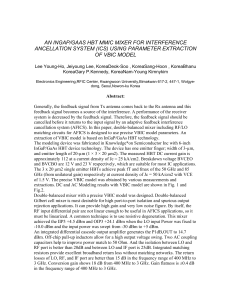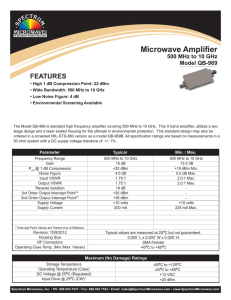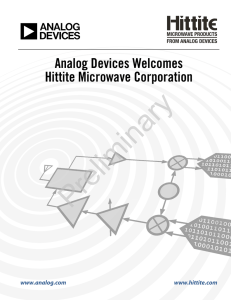MM1-0626SSM - Marki Microwave
advertisement

GaAs DOUBLE-BALANCED MIXER MM1-0626SSM The MM1-0626SSM is a highly linear passive GaAs double balanced MMIC mixer suitable for both up and downconversion applications. As with all Marki Microwave mixers, it features excellent conversion loss, isolation and spurious performance across a broad bandwidth and in a small form factor. The MM1-0626SSM is available in a lead-free, RoHS compliant QFN surface mount package and is compatible with standard leaded and lead-free PCB reflow soldering processes. The MM1-0626SSM is a superior alternative to Marki Microwave surface mount M1 and M3 mixers. Features +14 dBm Typical Input 1 dB Compression +24.5 dBm Typical Input IP3 Compact 3mm QFN SMT Style Package Excellent Unit-to-Unit Repeatability RoHS Compliant Electrical Specifications - Specifications guaranteed from -55 to +100C, measured in a 50Ω system. Specifications are shown for Configurations A & B. See page 2 for port locations. Parameter LO RF IF (GHz) (GHz) (GHz) Min Typ Max LO drive level (dBm) Conversion Loss (dB) (100 MHz) Configuration A Configuration B 8 10 Isolation (dB) LO-RF LO-IF RF-IF See Plots 6-26.5 6-24 (A Config.) (A Config.) DC-9 6-24 6-26.5 (B Config.) (B Config.) Input 1 dB Compression (dBm) Input Two-Tone Third Order Intercept Point (dBm) +14 +14 Config. A: +18 to +23 Config. B: +17 to +23 +24.5 +27.5 Config. A: +18 to +23 Config. B: +17 to +23 Part Number Options Model Number MM1-0626SSM-2 Description 1 EVAL-MM1-0626S 1 Surface Mount, IF Port Configuration -2 Connectorized Evaluation Fixture Note: For port locations and I/O designations, refer to the drawings on page 2 of this document. 215 Vineyard Court, Morgan Hill, CA 95037 | Ph: 408.778.4200 | Fax 408.778.4300 | info@markimicrowave.com 9/15/16 GaAs DOUBLE-BALANCED MIXER MM1-0626SSM Page 2 LO/RF 6 to 26.5 GHz IF DC to 9 GHz 1. Configuration A/B refer to the same part number (MM1-0626SSM) used in one of two different ways for optimal spurious performance. For the lowest conversion loss, use the mixer in Configuration A (port 1 as the LO input, port 2 as the RF input or output). If you need to use a lower LO drive, use the mixer in Configuration B (port 1 as the RF input or output, port 2 as the LO input). For optimal spurious suppression, experimentation or simulation is required to choose between Configuration A and B. For more information, see here. .003 Typ .114 PROJECTION INCH [MM] [.08] [2.90] .013 Typ [.32] Pad # 10 11 12 .114 [2.90] M1S 6017 XXYY 9 .059 [1.50] 1 Ground Paddle 8 2 7 .020 Typ [.50] 3 6 5 4 .012 Typ [.30] Configuration A Function 1 2 3 4 5 6 7 8 9 10 11 12 N/C LO N/C N/C IF N/C N/C RF N/C N/C N/C N/C Configuration B Function N/C RF N/C N/C IF N/C N/C LO N/C N/C N/C N/C .031 [.78] Outline Drawing – 3mm QFN package .000 .010 .030 .041 .061 .081 .092 .112 .122 Substrate material is Ceramic. I/O Leads and Ground Paddle are 1.4+0.6 microns (55+24 micro-inches) Au over 1.3 microns (51 micro-inches) Ni. All unconnected pads should be connected to PCB RF ground. .000 .010 .030 .041 .061 .081 .092 .112 .122 .031 Typ .012 .028 Typ Typ Ø.010 Plated Thru Hole, 22 PL .020 Typ QFN-Package Surface-Mount Landing Pattern Click here for a DXF of the above layout. Click here for leaded solder reflow. Click here for lead-free solder reflow. 9/15/16 GaAs DOUBLE-BALANCED MIXER MM1-0626SSM Page 3 LO/RF 6 to 26.5 GHz IF DC to 9 GHz Typical Performance Conversion Loss: 100 MHz IF (dB)1-4 -4 Conversion Loss: 2.5 GHz IF, 6-24 GHz LO (dB)1-4 -4 -6 -6 -8 -8 -10 -10 -12 -12 -14 -14 -16 -16 Configuration A Configuration B -18 Configuration A Configuration B -18 -20 -20 5 7 9 11 13 15 17 19 21 23 25 27 5 7 9 11 RF Frequency (GHz) -2 -4 -4 -6 -6 -8 9 GHz RF - Configuration A 9 GHz RF - Configuration B -10 0 1 2 3 4 5 6 7 -10 8 9 10 0 11 21 23 25 27 1 2 3 4 5 6 7 8 9 10 11 IF Frequency (GHz) Configuration A Conversion Loss vs. LO Power: 100 MHz IF (dB) 1-4 Configuration B Conversion Loss vs. LO Power: 100 MHz IF (dB) 1-4 -4 -6 -6 -8 -8 -10 -10 -12 -12 -14 -14 +22 dBm +18 dBm +17 dBm +16 dBm -16 -18 -20 5 7 9 11 13 +20 dBm +17 dBm +16 dBm +15 dBm -16 -18 -20 15 17 19 21 23 25 5 27 7 9 11 13 15 17 19 21 23 25 27 RF Frequency (GHz) RF Frequency (GHz) -4 19 23 GHz RF - Configuration A 23 GHz RF - Configuration B IF Frequency (GHz) -4 17 Relative IF Response (dB) 0 -2 -8 15 RF Frequency (GHz) Relative IF Response (dB) 0 13 Configuration A Conversion Loss vs. LO Power: 2.5 GHz IF (dB) 1-4 Configuration B Conversion Loss vs. LO Power: 2.5 GHz IF (dB) 1-4 -4 -6 -6 -8 -8 -10 -10 -12 -12 -14 -14 +22 dBm +18 dBm +17 dBm +16 dBm -16 -18 -20 5 7 9 11 13 +22 dBm +17 dBm +16 dBm +15 dBm -16 -18 -20 15 17 19 RF Frequency (GHz) 21 23 25 27 5 7 9 11 13 15 17 19 21 23 25 27 RF Frequency (GHz) 9/15/16 GaAs DOUBLE-BALANCED MIXER MM1-0626SSM Page 4 LO/RF 6 to 26.5 GHz IF DC to 9 GHz Typical Performance Input IP3: 100 MHz IF (dBm) 35 Output IP3: 100 MHz IF (dBm) 35 30 30 25 25 20 20 15 15 10 10 Configuration A Configuration B 5 Configuration A Configuration B 5 0 0 5 7 9 11 13 15 17 19 21 23 25 27 5 7 9 11 RF Frequency (GHz) -20 -30 -30 -40 -40 -50 -50 -60 -60 -70 -70 9 11 13 15 17 19 21 23 25 5 27 7 9 11 23 25 27 13 15 17 19 21 23 25 27 LO Frequency (GHz) LO Frequency (GHz) RF to IF Isolation (dB) 0 21 Configuration A Configuration B -80 -80 7 19 -10 -20 5 17 LO to IF Isolation (dB) 0 Configuration A Configuration B -10 15 RF Frequency (GHz) LO to RF Isolation (dB) 0 13 IF Return Loss (dB) 0 -10 -5 -20 -30 -10 -40 -15 -50 -20 -60 -70 -25 ConfigurationA Configuration B -80 5 7 9 11 13 15 17 19 9 GHz RF - Configuration A 9 GHz RF - Configuration B -30 21 23 25 27 0 1 2 3 RF Frequency (GHz) RF Return Loss (dB) 0 5 6 7 8 9 21 23 10 11 Small Signal LO Return Loss (dB) 0 Configuration A Configuration B -5 4 IF Frequency (GHz) Configuration A Configuration B -5 -10 -10 -15 -15 -20 -20 -25 -25 5 7 9 11 13 15 17 19 RF Frequency (GHz) 21 23 25 27 5 7 9 11 13 15 17 19 25 27 LO Frequency (GHz) 9/15/16 GaAs DOUBLE-BALANCED MIXER MM1-0626SSM Page 5 LO/RF 6 to 26.5 GHz IF DC to 9 GHz Typical Performance Even LO Harmonic to RF Isolation (dB) 0 2xLO Configuration A 4xLO Configuration A -10 -20 Even LO Harmonic to IF Isolation (dB) 0 2xLO Configuration B 4xLO Configuration B 2xLO Configuration A 4xLO Configuration A -10 -20 -30 -30 -40 -40 -50 -50 -60 -60 -70 -70 -80 -80 2xLO Configuration B 4xLO Configuration B -90 -90 6 8 10 12 14 16 18 20 22 24 6 26 8 10 12 Odd LO Harmonic to RF Isolation (dB) 0 -10 -10 -20 -20 -30 -30 -40 -40 -50 -50 -60 -60 -70 -70 3xLO Configuration A -90 6 8 10 12 14 -80 3xLO Configuration B 16 18 20 22 24 3xLO Configuration A -90 26 6 8 10 18 20 22 24 26 12 14 3xLO Configuration B 16 18 20 22 24 26 LO Output Frequency (GHz) LO Output Frequency (GHz) 2RF x 2LO Spurious Suppression (dBc) -10 dBm RF Input 0 16 Odd LO Harmonic to IF Isolation (dB) 0 -80 14 LO Output Frequency (GHz) LO Output Frequency (GHz) 2IF x 1LO Spurious Suppression (dBc) -10 dBm IF Input 0 -10 -10 -20 Configuration A -20 Configuration A -30 Configuration B -30 Configuration B -40 -40 -50 -50 -60 -60 -70 -70 -80 -80 -90 -90 -100 -100 6 8 10 12 14 16 18 20 RF Input Frequency (GHz) 22 24 26 6 8 10 12 14 16 18 20 22 24 26 RF Output Frequency (GHz) 9/15/16 GaAs DOUBLE-BALANCED MIXER MM1-0626SSM Page 6 LO/RF 6 to 26.5 GHz IF DC to 9 GHz Downconversion Spurious Suppression Spurious data is taken by selecting RF and LO frequencies (+mLO+nRF) within the 6 to 26.5 GHz RF/LO bands, which create a 100 MHz IF spurious output. The mixer is swept across the full spurious band and the mean is calculated. The numbers shown in the table below are for a -10 dBm RF input. Spurious suppression is scaled for different RF power levels by (n-1), where “n” is the RF spur order. For example, the 2RFx2LO spur is 74 dBc for the A configuration for a -10 dBm input, so a -20 dBm RF input creates a spur that is (2-1) x (-10 dB) dB lower, or 84 dBc. Typical Downconversion Spurious Suppression (dBc): A Configuration (B Configuration) 5 -10 dBm RF Input 0xLO 1xLO 2xLO 3xLO 4xLO 5xLO 1xRF 25 (24) Reference 31 (43) 13 (12) 35 (39) 15 (20) 2xRF 65 (68) 67 (64) 74 (79) 72 (60) 80 (82) 75 (72) 3xRF 93 (92) 72 (81) 92 (95) 83 (88) 88 (95) 77 (84) 4xRF 112 (111) 115 (116) 119 (119) 119 (119) 119 (120) 120 (120) 5xRF 120 (120) 115 (131) 131 (131) 131 (131) 132 (131) 127 (129) Upconversion Spurious Suppression Spurious data is taken by mixing a 100 MHz IF with LO frequencies (+mLO+nIF), which creates an RF within the 6 to 26.5 GHz RF band. The mixer is swept across the full spurious output band and the mean is calculated. The numbers shown in the table below are for a -10 dBm IF input. Spurious suppression is scaled for different IF input power levels by (n-1), where “n” is the IF spur order. For example, the 2IFx1LO spur is typically 73 dBc for the A configuration for a -10 dBm input, so a -20 dBm IF input creates a spur that is (2-1) x (-10 dB) dB lower, or 83 dBc. Typical Upconversion Spurious Suppression (dBc): A Configuration (B Configuration) 5 -10 dBm IF Input 0xLO 1xLO 2xLO 3xLO 4xLO 5xLO 1xIF 29 (19) Reference 33 (41) 10 (9) 34 (40) 22 (27) 2xIF 76 (58) 73 (72) 63 (56) 70 (76) 65 (63) 80 (71) 3xIF 93 (93) 76 (81) 88 (94) 73 (76) 89 (93) 72 (78) 4xIF 118 (109) 120 (119) 115 (114) 121 (117) 113 (115) 119 (120) 5xIF 129 (127) 128 (130) 131 (130) 129 (129) 131 (132) 120 (127) 9/15/16 GaAs DOUBLE-BALANCED MIXER MM1-0626SSM Page 7 LO/RF 6 to 26.5 GHz IF DC to 9 GHz Application Circuit 12 LO 11 10 12 11 10 1 9 1 9 2 8 2 8 3 7 3 7 4 5 6 IF (low frequency signal) DC/RF Ground RF (high frequency signal) RF (high frequency signal) 4 5 6 IF (low frequency signal) Configuration A LO DC/RF Ground Configuration B Operation IF Port – Used as input on an upconversion, output on downconversion, or LO port in a band shifting application. Signals should be connected by 50 ohm microstrip or coplanar traces to well matched broadband 50 ohm sources and loads. Blocking capacitor is recommended if DC voltage is present on the line. RF Port – Used as input on a downconversion, output on upconversion, or output in a band shifting application. Signals should be connected by 50 ohm microstrip or coplanar traces to well matched broadband 50 ohm sources and loads. Filtering and Matching- Filtering is generally desired for spurious and image removal on the output port of the mixer. Reflective filters can cause out of band signals to reflect back into the mixer and cause conversion loss ripple, erroneous spurs, and other undesired behaviors. To eliminate these problems it is recommend that the filters be placed as close to the output port as possible. If undesired behavior is still observed, a diplexer with one port terminated or a 1-3 dB attenuator may reduce this problem. RF Ground – The ground paddle of the QFN should be connected to a low noise RF ground with very low electrical resistance for high frequency operation. LO Port – The noise floor of the LO input signal should be less than the value of the noise floor plus isolation of the mixer, or a filter is recommended to prevent reduction in dynamic range. An LO amplifier is required if the LO power is below the recommended drive level. It is important to use an amplifier with a broadband 50 ohm match such that it does not reflect spurious signals back into the mixer or other system circuitry. Recommended LO Amplifier Package SM Diode Option Amplifier S ADM-0126-5835SM 9/15/16 GaAs DOUBLE-BALANCED MIXER MM1-0626SSM Page 8 LO/RF 6 to 26.5 GHz IF DC to 9 GHz Port Description Port 2 Port 2 is DC open and AC matched to 50 Ohms from 6 to 26.5 GHz. Blocking capacitor is optional. Port 5 Port 5 is DC coupled to the diodes. Blocking capacitor is optional. Port 8 Port 8 is DC open and AC matched to 50 Ohms from 6 to 26.5 GHz. Blocking capacitor is optional. DC Interface Schematic P2 P5 P8 Absolute Maximum Ratings Parameter Maximum Rating Port 2 DC Current N/A Port 5 DC Current 15 mA Port 8 DC Current N/A RF Power Handling (RF+LO) +28 dBm at +25°C, derated linearly to +24 dBm at +100°C Operating Temperature -55ºC to +100ºC Storage Temperature -65ºC to +125ºC DATA SHEET NOTES: 1. Mixer Conversion Loss Plot IF frequency is 100 MHz. 2. Mixer Noise Figure typically measures within 0.5 dB of conversion loss for IF frequencies greater than 5 MHz. 3. Conversion Loss typically degrades less than 0.5 dB at +100°C and improves less than 0.5 dB at -55°C. 4. Unless otherwise specified, data is taken with +20 dBm LO drive. 5. Specifications are subject to change without notice. Contact Marki Microwave for the most recent specifications and data sheets. 6. Catalog mixer circuits are continually improved. Configuration control requires custom mixer model numbers and specifications. Marki Microwave reserves the right to make changes to the product(s) or information contained herein without notice. Marki Microwave makes no warranty, representation, or guarantee regarding the suitability of its products for any particular purpose, nor does Marki Microwave assume any liability whatsoever arising out of the use or application of any product. © Marki Microwave, Inc. 215 Vineyard Court, Morgan Hill, CA 95037 | Ph: 408.778.4200 | Fax 408.778.4300 | info@markimicrowave.com www.markimicrowave.com 9/15/16



